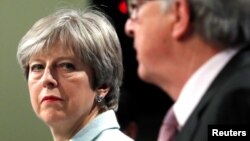There was relief in London and Brussels Friday after Britain clinched an initial agreement on its terms of divorce from the European Union, opening the way for the next — and even harder — phase of negotiations over the country's future trade relations with the economic bloc.
“Let us remember that the most difficult challenge is still ahead,” Donald Tusk, the president of the European Council, warned after the overnight deal was struck. “We all know that breaking up is hard. But breaking up and building a new relation is much harder.”
'Give and take on both sides'
Welcoming Friday’s deal, which guarantees the rights of Europeans living in Britain and Britons residing in EU countries, as well as committing not to reestablish a customs border between Northern Ireland and the Republic of Ireland, a bleary-eyed British Prime Minister Theresa May said there had been “give and take on both sides.”
Her aides say the deal was a triumph for her.
But many of the red lines she had laid down previously were crossed to pull off the breakthrough, analysts say.
To clinch the deal, May had to agree that the European Court of Justice will oversee the rights of EU citizens in Britain, for at least a minimum of eight years after Britain formally breaks from the EU, which is scheduled next year. She also agreed on an expensive exit bill, which will amount to $47-$53 billion.
'Regulatory alignment'
And to the anger of Brexiters, May also agreed that Britain will maintain “regulatory alignment” with the EU to ensure there doesn’t have to be a “hard border” or regulatory barriers between Northern Ireland and the Republic of Ireland. That suggests to them that Britain is likely heading for a so-called “soft Brexit,” whereby it remains entangled with the EU.
The former leader of the UK Independence Party, Nigel Farage, scathingly described the 15-page draft agreement — it still has to be endorsed by EU national leaders next week — as “pathetic.”
He added: “The British prime minister had to fly through the middle of the night to go meet three unelected people who condescendingly are now saying ‘Jolly well done, May. You've met every single one of our demands. Thank you very much, we can now move on.’”
May and Jean-Claude Juncker, the European Commission president, had originally planned to agree on a first-phase deal on Monday, but it was thwarted in a chaotic breakdown between the British prime minister and Northern Ireland's Democratic Unionist Party (DUP), who May needs for her parliamentary majority.
The DUP objected to some of the border commitments May was making.
Terms a tough sell?
For May, the challenge now may be to sell the terms of the divorce agreement to her own Conservative party.
Brexiters within her cabinet, including Foreign Secretary Boris Johnson and Environment minister Michael Gove, who both challenged her for the party leadership last year, were supportive of May publicly Friday.
“How long she will retain their backing? I wouldn’t like to place a wager on that,” remarked a Conservative lawmaker.
The promise that Britain will maintain close regulatory alignment with many of the EU single market’s rules and regulations for the sake of Northern Ireland and the Republic of Ireland, even after leaving the economic bloc, quickly attracted criticism from other Brexiters Friday.
Former official has concerns
One former Conservative minister, Owen Paterson, tweeted his concern over the alignment pledge — as well as divorce bill — saying they “must be debated and resolved.” He warned ominously, “Nothing is agreed until everything is agreed.”
Other Brexiters said the agreement to maintain regulatory alignment between Britain and the EU was inconsistent with May’s pledge that “Brexit means Brexit.”
They argue by entangling Britain with EU regulations, it will make it harder for Britain to strike out and to negotiate bilateral trade deals with other countries.
They are suspicious also that, despite May’s insistence, Britain will leave the bloc’s customs union — which she is on course to keep Britain in — pushed to do so by ministers who want to retain a close relationship with the EU and opposition lawmakers in the House of Commons opposed to Brexit.
No 'hard Brexit'
Their fears might not be misplaced. A former head of the British Foreign Office, Simon Fraser, says Friday’s deal makes it less likely there will be a sharp “hard Brexit” from the EU. But he says trade discussions will prove even harder than the first phase with “much bigger and more complicated negotiations.”
“We need a much clearer understanding of what our negotiating strategy is,” he told Britain’s Sky News.
For all sides in the Brexit divide roiling British politics there remains much to fight over, including the biggest of all questions: What should Britain’s future relationship with the EU look like? The first-phase deal is full of ambiguity and fudge and leaves more questions unresolved than it answers, analysts say.
According to former Conservative lawmaker and newspaper columnist Matthew Parris, “Theresa May’s supposed victory merely prolongs the illusions and postpones the hard decisions.”









